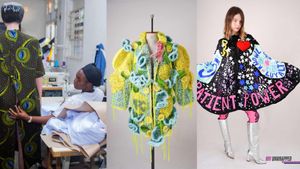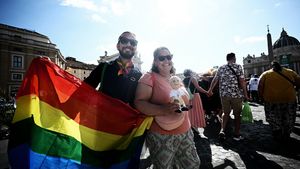Countless myths and legends swirl around the papacy, from the Papal Tiara bearing the supposed sign of the devil to the infamous Banquet of Chestnuts. The latter was recently depicted in the 2010 Showtime series The Borgias, following the Borgia family as Rodrigo de Borja (played by Jeremy Irons) becomes Pope Alexander VI. Another scene from papal mythology unfolds in the pilot episode of the series. Shortly after being elected in conclave, the new pope sits on a chair where, to viewers’ surprise (and, assumedly, cold hands), the holy genitals are inspected to ensure Alexander is biologically male.
The legend of the sedes stercoraria, or the dung chair, is one of many written over the centuries by many sources. But why was this legend told and popularized, even in the modern era? Enter Johannes Anglicus or Pope Joan, the first and only woman to become Pope.
None of the countless myths swirling around the papacy has captured popular imagination like Pope Joan. A brilliant woman who became the Bishop of Rome sometime in the ninth century, her secret was unraveled most spectacularly. She went into labor during a public procession and allegedly died amid the shock of the crowd.
Not to say popes (and other high-ranking ecclesiastics) were upright persons. Pope Alexander VI publicly legitimized four of his children after becoming pope. But Joan was transgressive in many ways: a gender outlaw and an intellectual prodigy, a representation of forbidden knowledge who topples an all-male hierarchy. Little wonder the legend has refused to die, even though professional historians have pronounced her pontificate pure fiction for decades.
Official Vatican lists insist that every one of the 266 pontiffs has been male. Yet beginning in the mid-1200s, a mysterious name - Ioannes Anglicus, later recast as “Pope Joan” – suddenly bloomed in European chronicles, squeezed between 9th-century popes Leo IV and Benedict III. The earliest mention comes from the Dominican friar Jean de Mailly, who tucked a short anecdote about a woman-pope into his Chronica universalis Mettensis sometime in the early 1200s. Roughly two decades later, Martinus Polonus (Martin of Opava) copied and embellished the story in his wildly popular Chronicon Pontificum et Imperatorum, giving it legs that would stride across the Christian world for centuries.
Martin’s account provided the scaffolding that later storytellers draped with lurid details. In the standard version, Joan was a Saxon or English prodigy educated in Athens. She later donned male ecclesiastical garb, wowed Rome with her intellect, and was unanimously elected the pope as “John VIII.” Her downfall came two-plus years later when riding in a solemn procession, she went into labor and delivered a child in a Roman street. The mother died—from shock, stoning, or sheer disgrace, depending on who’s telling—and the infant soon after. Medieval guides swore future popes avoided that lane like the plague, detouring left onto what was nicknamed Via Sacra or “The Sacred Way,” later earning the moniker “Shunned Street.”
To a thirteenth-century reader, the tale felt oddly plausible. Europe was awash in miracle stories, moral exempla, and disguised-saint narratives. A female pontiff folded three popular motifs into one sensational package: God’s penchant for surprise, the peril of unchecked ambition, and a possible dig at clerical hypocrisy (what business had Rome letting a woman climb so goddamn high?) It also fits contemporary anxieties about gender inversion and textual warnings against women playing an active and influential role in the Church.
Legends rarely stay between the lines of parchment. By the 1400s, Joan had strolled onto cathedral walls, marble busts, marginal illustrations, and even playing cards. Ironically, artworks helped fossilize the story just as emerging scholars began to question the myth of the female pope. After all, once people see a thing, they’re rarely loath to unsee it.
The first rumblings of doubt surfaced in the late fifteenth century, with scholars like Aeneas Silvius and Platina questioning the chronology of Joan’s reign. As the Protestant Reformation unfolded in the sixteenth century, critics declared the popess myth part of a Protestant smear to discredit Rome. Though the official records showed no proof, several Protestant scholars and critics of the Church used Joan’s narrative as an example of Rome’s corruption. Today, virtually all academic medievalists call Pope Joan’s reign a papal urban legend. No record notes an interregnum, with papal charters and letters running smoothly from Leo IV to Benedict III. The street said to host her demise didn’t acquire its ominous nickname until after the legend spread. Even the famous “testicle throne” on which new popes proved their maleness turned out to be a reused Roman latrine chair misinterpreted by gossip hunters.
Yet, with every scholarly debunking, films, novels, and theories rise to resurrect Joan.
So, why does a disproven story find such fertile soil centuries on? Because symbols can—and often do—outrun facts. To Catholic reformists, Joan embodies the hope of the Church’s openness toward its most marginalized faithful. To feminists, she’s a cautionary parable of glass ceilings disguised as vaulted naves. Queer readers glimpse in her cross-dressing subversion a proto-trans or non-binary figure surviving in patriarch’s mostly male bastion. Even tarot enthusiasts can read the High Priestess card (formerly la Papesse) as divine feminine wisdom hidden beneath patriarch titles. The Joan myth continues even into the twenty-first century. Donna Wollfolk Cross’s best-selling 1996 novel on the legendary popess reframed the tale as an empowering historical fiction; the 2009 German film adaptation added some grit.
Whether or not Joan lived, she lives on as hope and protest.
Strip away the miters and manuscripts, and Pope Joan stands revealed as an exquisite barometer of cultural desire. She measures how badly the medieval imagination wanted to test papal invulnerability, how earnestly early modern critics craved ammunition, and how passionately modern audiences hunger for heroines who crack glass—or marble, in this case—ceilings. That historians can’t place her in the Vatican’s marble halls matters less than the questions she keeps alive: Who can speak for the Divine? Who gets to decide who speaks? And what stories, real or rumored, will we invent next to pry those sacred doors open a little wider? Until the Church ordains women (and perhaps even after), expect Joan to keep haunting tour guides and be discovered through podcasts and social media posts.
Legends, like faith, endure where evidence ends and possibility begins.
Marie-Adélina de la Ferrière is the Community Editor for equalpride, the publish of The Advocate. She earned a Master's in World History from SUNY Brockport, specializing in European History.
Voices is dedicated to featuring a wide range of inspiring personal stories and impactful opinions from the LGBTQ+ and Allied community. Visit Advocate.com/submit to learn more about submission guidelines. We welcome your thoughts and feedback on any of our stories. Email us at voices@equalpride.com. Views expressed in Voices stories are those of the guest writers, columnists and editors, and do not directly represent the views of The Advocate or our parent company, equalpride.




































































Charlie Kirk DID say stoning gay people was the 'perfect law' — and these other heinous quotes